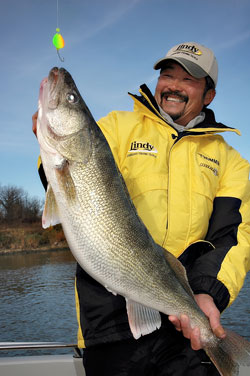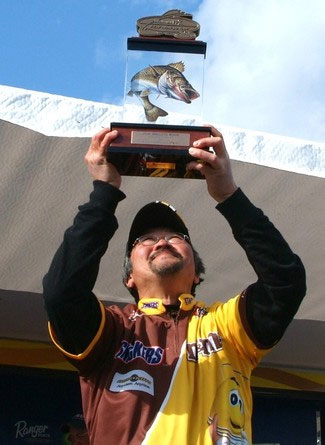It’s been 19 years this month when I first met Ted Takasaki. Since then, we’ve been one of the most prolific outdoor writing teams in North America. We’ve regularly appeared in Midwest Outdoors, Fishing Facts and a host of other top angling publications and web sites.
It’s been 19 years this month when I first met Ted Takasaki. Since then, we’ve been one of the most prolific outdoor writing teams in North America. We’ve regularly appeared in Midwest Outdoors, Fishing Facts and a host of other top angling publications and web sites.
 At the same time, Ted has gone on to become one of the leading fishing authorities in the nation.
At the same time, Ted has gone on to become one of the leading fishing authorities in the nation.
Most of all, we’ve become the closest of friends. At the end of the day, that’s the most important thing about fishing – the good people you meet and the friends you make along the way.
That’s why I asked him to allow me to write this article alone. He is the subject. Maybe you have heard the news already. He was named a Legendary Angler by the Fresh Water Fishing Hall of Fame at Hayward, Wisconsin. Only 120 other anglers have achieved that distinction since the Hall opened in the early 1980s. Others include Al and Ron Lindner, Spence Petros, Bill Binkelman (who taught us the value of the lowly nightcrawler), Babe Winkelman, Jimmy Houston, Hank Parker, the late Tony Dean, and Bill Dance.
“I couldn’t be more honored and humbled to be a part of this prestigious group of anglers,” Ted told me while I interviewed him for this article.
Funny, isn’t it, how events you expect to be routine turn out to be life-changing? That certainly was true about a fishing trip I took in the early spring of 1992. I was just looking for stories for my fishing column in the Bloomington Pantagraph, where I worked. I phoned Bob “Kaz” Kaczkowski and his wife, Bev, who ran the Masters Walleye Circuit, which begins its season every year with a March event at Spring Valley on the Illinois River. I asked Kaz to hook me up with an MWC angler, preferably one from Illinois who could take me fishing on the river while I interviewed him. I remember Kaz said, “I know just the guy.”
The guy turned out to be Ted. He smiled that big trademark smile as we shook hands and he welcomed me aboard. He told me he grew up in a small town in Central Illinois. His brother used to deliver the Pantagraph newspaper. Then Ted laughed as he said he delivered the Kankakee newspaper because it came out in the afternoon and he didn’t like to get up too early. He told me how his father taught him to fish in farm ponds for bluegills and bass.
I grew up just a few miles away from the Illinois River, in Streator. My grandparents lived in Tonica, billed as “The Back Door to Starved Rock,” so I was around the river and its tributaries, like the Vermilion, all my life.
But, I’d never seen the river in the way Ted showed it to me that day.
Ted was just 34, a computer systems salesman with Hewlett Packard based in the Chicago area. His MWC fishing partner was John Campbell, who also worked for Hewlett Packard. They had been fishing together since they met at the University of Illinois.
They had decided to enter the MWC event on the Illinois River on a lark in 1989. They blanked. But, they were competitive and worked hard on the circuit the next year. By 1991, the Takasaki/Campbell team reigned as MWC Team of the Year.
Already sponsored by Lindy, Ted taught me how to fine-tune a river jigging presentation. We used Fuzz-E-Grub jigs as we searched for big saugers from Starved Rock to Henry on the river. The topic was the subject of our first magazine article.
Double Jig Rigs were the newest things at the time. I learned how to catch fish going upstream at the pace of a slow walk. We were soon writing about those, too.
I met John Campbell, Jim Saric, and others that day. I learned the mental game of tournament fishing. For example, I set the hook on a fish just as another tournament competitor motored up to Ted to talk. Ted had warned me earlier to be subtle when we caught fish so we wouldn’t be giving away spots. I put the rod tip down below the water so the visitors couldn’t see the rod bend while the fish was trying to get away. When they left, I reeled it in with Ted chuckling away.
He’s taught me an incredible amount about fishing during our interviews and on our trips throughout North America’s walleye range. I’ve had some of the best times of my life on trips with him to Anderson’s Lodge on Lac Seul, Ontario.
Lake Erie was one trip I’ll never forget. We pulled out of Put-In-Bay, Ohio, to pre-fish, into high 5- to 6-foot rollers. Ted motored us 10 miles to the west to escape some of the wind. He baited a spinner rig, lowered it to the bottom and set the hook before he handed it to me and told me to reel it in. It weighed 8 pounds.
In 2002, a few years later, he set a one-day, five-fish tournament record that still stands, 53.2 pounds. He caught them open-water trolling with crankbaits. “Unbelievable. That was a pretty good day,” remembers Ted. “I didn’t even realize they were that big until I started sorting through them at check-in. There was little water in the livewell because it was all teeth and fins.”
He has also earned a reputation as one of the best precision trollers in the business in addition to being one of the best jig anglers on the circuit.
In 1995, Ted won the “Top Gun” award for being the most consistent angler on the Professional Walleye Tour. In 1998, he won the PWT championship on the Missouri River using Fuzz-E-Grub jigs again. He won the FLW event on the Mississippi River at Lake Pepin last year trolling with lead core.
 He credits his versatility to Spence Petros. Just out of college while in the Chicago area, Ted, Campbell, and Saric all took Spence’s fishing classes on locating and catching fish. From there, Ted credits the demanding atmosphere of tournaments which forced him to constantly learn new tactics to meet the challenge.
He credits his versatility to Spence Petros. Just out of college while in the Chicago area, Ted, Campbell, and Saric all took Spence’s fishing classes on locating and catching fish. From there, Ted credits the demanding atmosphere of tournaments which forced him to constantly learn new tactics to meet the challenge.
“Spence provided me with vital core fishing knowledge and the tournaments have made me the angler I am,” Ted said. “A person who stays on one body of water, one lake… they just can’t learn as much. Tournaments push you to learn new water, new techniques and to get better in order to be competitive.”
Ted’s not only an expert at catching walleyes. Of course, they are a specialty, his bread and butter. But Ted is also a muskie fanatic. His first muskie ever boated was a 51-inch fish caught in his first ever tournament. I was with him when he launched his boat on a new lake, sat behind the steering wheel analyzing a lake map as the Mercury warmed up, motored to a weedy neckdown spot and boated a 47-inch muskie all in about 30 minutes. On nearby Mille Lacs, he boated three more fish between 48 and 51 inches during the next three nights.
He can also lead the search for largemouth and smallmouth bass and a host of panfish species on both open water and ice.
The best advice he ever received as a beginning tournament angler? “Keep your day job,” he said. That led to a stint as president of Lindy which ended 2 years ago after the company was sold. Now, as a pro-staffer for Lindy, he is excited about getting to where he wanted to be when he started. To fish full-time for a living!
Here is his advice to new anglers striving to make a living at fishing – besides keeping your day job, that is:
- Have patience and prepare: “If you do everything you can ahead of time to be prepared, the right opportunity will come.”
- Stay positive – even when things are tough: “Everybody runs into tough times. It’s really how you react to the factors around you that effects what the future is going to bring.”
- Treat people right: “Always treat people the way you want to be treated. That’s always been my motto.”
- Build a good team: “No matter what area of life you’re talking about, no one reaches great heights without help.”
About this honor from the Hall of Fame: “I wouldn’t have been able to do it without the help of so many different people. You cannot get to where you are without the help of friends and mentors. There have been so many, including Spence Petros, John Campbell, Scott Richardson, and Jim Saric. Gary Parsons provided me with valuable tips on sponsorships. Steve Pennaz and Tim Lesmeister both invited me to my first photo shoots. Jeff Murray taught me the value of a good camera. Mark Strand, the late John Husar, Mike Jackson, Nick Adams, Midwest Outdoors, and so many others were all vital parts of my career.”
The best part of this story is that the Hall of Fame is not the end. Unlike the baseball or football halls of fame, Legendary Anglers don’t have to be retired to qualify. Ted is only 53. He has many more chapters of his story to write. It will be fun watching it happen.










